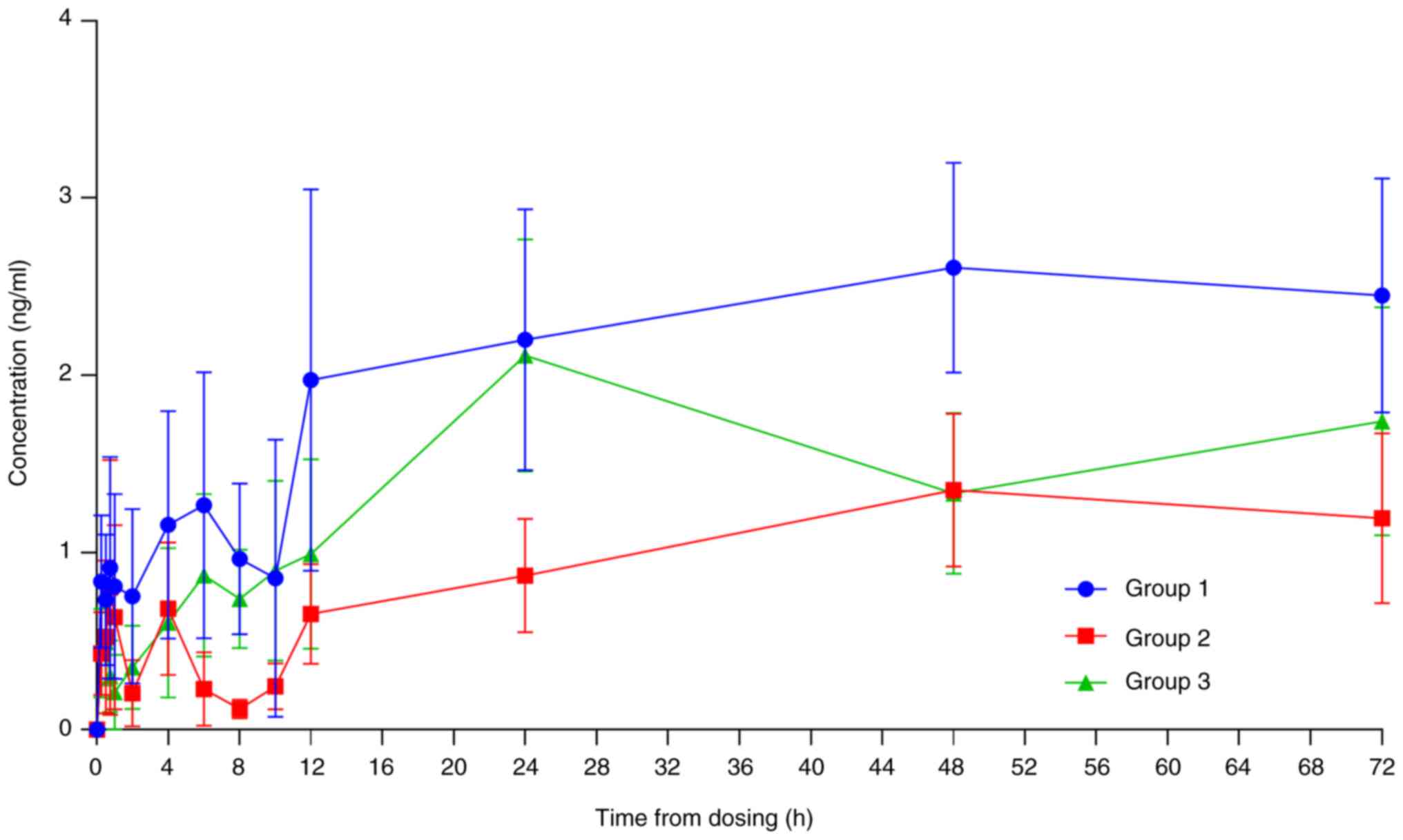|
1
|
Pludowski P, Takacs I, Boyanov M, Belaya
Z, Diaconu CC, Mokhort T, Zherdova N, Rasa I, Payer J and Pilz S:
Clinical practice in the prevention, diagnosis and treatment of
vitamin D deficiency: A Central and Eastern European expert
consensus statement. Nutrients. 14(1483)2022.PubMed/NCBI View Article : Google Scholar
|
|
2
|
Kennel KA, Drake MT and Hurley DL: Vitamin
D deficiency in adults: When to test and how to treat. Mayo Clin
Proc. 85:752–758. 2010.PubMed/NCBI View Article : Google Scholar
|
|
3
|
Palacios C and Gonzalez L: Is vitamin D
deficiency a major global public health problem? J Steroid Biochem
Mol Biol. 144:138–145. 2014.PubMed/NCBI View Article : Google Scholar
|
|
4
|
Pfotenhauer KM and Shubrook JH: Vitamin D
deficiency, its role in health and disease, and current
supplementation recommendations. J Am Osteopath Assoc. 117:301–305.
2017.PubMed/NCBI View Article : Google Scholar
|
|
5
|
Itkonen ST, Erkkola M and Lamberg-Allardt
CJE: Vitamin D fortification of fluid milk products and their
contribution to vitamin D intake and vitamin D status in
observational studies-a review. Nutrients. 10(1054)2018.PubMed/NCBI View Article : Google Scholar
|
|
6
|
Pellegrino L, Marangoni F, Muscigiuri G,
D'Incecco P, Duval GT, Annweiler C and Colao A: Vitamin D
fortification of consumption cow's milk: Health, nutritional and
technological aspects. A multidisciplinary lecture of the recent
scientific evidence. Molecules. 26(5289)2021.PubMed/NCBI View Article : Google Scholar
|
|
7
|
Tippetts M, Martini S, Brothersen C and
McMahon DJ: Fortification of cheese with vitamin D3 using dairy
protein emulsions as delivery systems. J Dairy Sci. 95:4768–4774.
2012.PubMed/NCBI View Article : Google Scholar
|
|
8
|
Denker AE, Lazarus N, Porras A,
Ramakrishnan R, Constanzer M, Scott BB, Chavez-Eng C, Woolf E,
Maganti L, Larson P, et al: Bioavailability of alendronate and
vitamin D3 in an alendronate/vitamin D3 combination tablet. J Clin
Pharmacol. 51:1439–1448. 2011.PubMed/NCBI View Article : Google Scholar
|
|
9
|
von Restorff C, Bischoff-Ferrari HA and
Theiler R: High-dose oral vitamin D3 supplementation in
rheumatology patients with severe vitamin D3 deficiency. Bone.
45:747–749. 2009.PubMed/NCBI View Article : Google Scholar
|
|
10
|
Ross AC, Taylor CL, Yaktine AL and Del
Valle HB: Institute of Medicine (US) Committee to Review Dietary
Reference Intakes for Vitamin D and Calcium. National Academies
Press, Washington, DC, pp1-1115, 2011.
|
|
11
|
Australian Government, Department of
Health and Aged Care: Vitamin D. Australian Government, Woden, ACT
2606, 2017. https://www.tga.gov.au/resources/publication/scheduling-decisions-interim/scheduling-delegates-interim-decisions-and-invitation-further-comment-accsacms-november-2016/31-vitamin-d#:~:text=Vitamin%20D%20has%20low%20toxicity,is%20very%20difficult%20to%20overdose.
Accessed January 2024.
|
|
12
|
Marwaha RM and Dabas A: Bioavailability of
nanoemulsion formulations vs conventional fat soluble preparations
of cholecalciferol (D3)-an overview. J Clin Orthop Trauma.
10:1094–1096. 2019.PubMed/NCBI View Article : Google Scholar
|
|
13
|
Raimundo FV, Lang MAB, Scopel L, Marcondes
NA, Araújo MG, Faulhaber GA and Furlanetto TW: Effect of fat on
serum 25-hydroxyvitamin D levels after a single oral dose of
vitamin D in young healthy adults: A double-blind randomized
placebo-controlled study. Eur J Nutr. 54:391–396. 2015.PubMed/NCBI View Article : Google Scholar
|
|
14
|
Radicioni M, Caverzasio C, Rovati S, Giori
AM, Cupone I, Marra F and Mautone G: Comparative bioavailability
study of a new vitamin D3 orodispersible film versus a marketed
oral solution in healthy volunteers. Clin Drug Investig.
42:151–161. 2022.PubMed/NCBI View Article : Google Scholar
|
|
15
|
Dawson-Hughes B, Harris SS, Palermo NJ,
Ceglia L and Rasmussen H: Meal conditions affect the absorption of
supplemental vitamin D3 but not the plasma 25-hydroxyvitamin D
response to supplementation. J Bone Miner Res. 28:1778–1783.
2013.PubMed/NCBI View Article : Google Scholar
|
|
16
|
Ilahi M, Armas LAG and Heaney RP:
Pharmacokinetics of a single, large dose of cholecalciferol. Am J
Clin Nutr. 87:688–691. 2008.PubMed/NCBI View Article : Google Scholar
|
|
17
|
Roth DE, Mahmid AA, Raqib R, Black RE and
Baqui AH: Pharmacokinetics of a single oral dose of vitamin D3
(70,000 IU) in pregnant and non-pregnant women. Nutr J.
11(114)2012.PubMed/NCBI View Article : Google Scholar
|
|
18
|
Raimundo FV, Faulhaber GAM, Menegatti PK,
da Silva ML and Furlanetto TW: Effect of high-versus low-fat meal
on serum 25-hydroxyvitamin D levels after a single oral dose of
vitamin D: A single-blind, parallel, randomized trial. Int J
Endocrinol. 2011(809069)2011.PubMed/NCBI View Article : Google Scholar
|
|
19
|
Dawson-Hughes B, Harris SS, Lichtenstein
AH, Dolnikowski G, Palermo NJ and Rasmussen H: Dietary fat
increases vitamin D-3 absorption. J Acad Nutr Diet. 115:225–230.
2015.PubMed/NCBI View Article : Google Scholar
|
|
20
|
Chuang J, Briskey D, Dang J, Rajgopal A
and Rao A: A randomized double-blind trial to measure the
absorption characteristics of eicosapentaenoic acid and
docosahexaenoic acid rich oil blend with natural lipid-based
delivery system. Food Sci Biotech. 33:1957–1964. 2023.PubMed/NCBI View Article : Google Scholar
|
|
21
|
Lark RK, Lester GE, Ontjes DA, Blackwood
AD, Hollis BW, Hensler MM and Aris RM: Diminished and erratic
absorption of ergocalciferol in adult cystic fibrosis patients. Am
J Clin Nutr. 73:602–606. 2001.PubMed/NCBI View Article : Google Scholar
|
|
22
|
Wortsman J, Matsuoka LY, Chen TC, Lu Z and
Holick MF: Decreased bioavailability of vitamin D in obesity. Am J
Clin Nutr. 72:690–693. 2000.PubMed/NCBI View Article : Google Scholar
|
|
23
|
Abboud M, Rybchyn MS, Liu J, Ning Y,
Gordon-Thomson C, Brennan-Speranza TC, Cole L, Greenfield H, Fraser
DR and Mason RS: The effect of parathyroid hormone on the uptake
and retention of 25-hydroxyvitamin D in skeletal muscle cells. J
Steroid Biochem Mol Biol. 173:173–179. 2017.PubMed/NCBI View Article : Google Scholar
|










